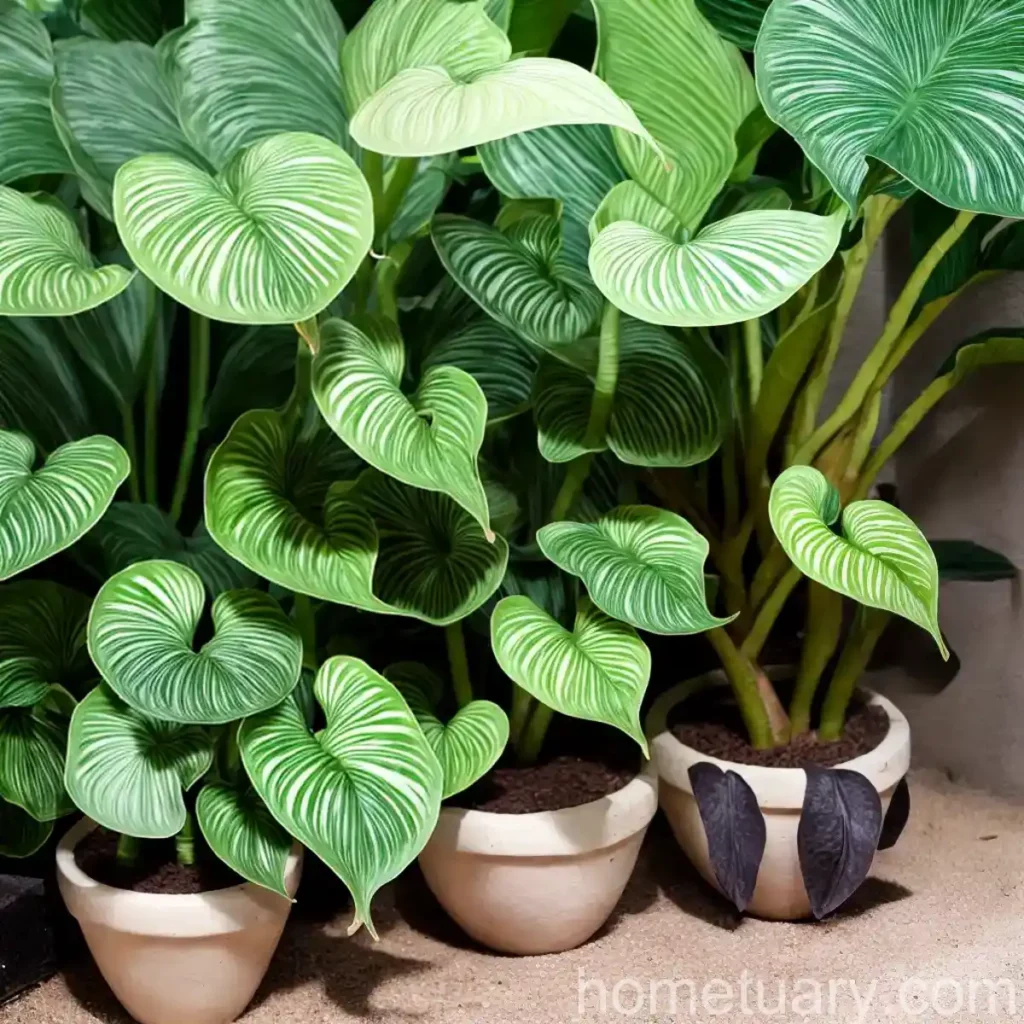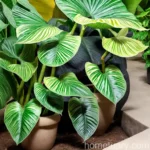Elephant’s Ear (Alocasia Low Rider) Plant Care Guide
Welcome to our comprehensive guide on the care and cultivation of one of the most striking and intriguing tropical plants, the elephant’s ear Alocasia Low Rider. This guide will equip you with the knowledge and techniques to ensure your Alocasia Low Rider thrives and adds a touch of exotic beauty to your indoor or outdoor space. We’ll cover everything from its cultural requirements and propagation to common diseases and pests, providing you with the tools for successful horticulture.
What is Elephant’s Ear (Alocasia Low Rider)?
The Alocasia Low Rider, also known as elephant’s ear, is a stunning tropical plant prized for its large, dramatic leaves and striking appearance. Belonging to the Araceae family, this plant is native to the tropical regions of Asia and East Africa. It is characterized by its upright growth habit and sculptural, arrowhead-shaped leaves with prominent veining, which resemble the ears of an elephant, hence its common name.
The Alocasia Low Rider is a popular choice for indoor and outdoor gardens due to its impressive foliage and tropical allure. It thrives in warm, humid environments and can be cultivated as a striking focal point or as part of a lush, green ensemble. Its unique beauty and adaptability make it a sought-after addition to any plant collection.
Let’s delve into the key aspects of caring for this magnificent plant.
Key Takeaways – Elephant’s Ear (Alocasia Low Rider)
Before we dive into the specific care requirements, let’s outline some key takeaways for successfully nurturing Alocasia Low Rider:
- Alocasia Low Rider thrives in warm, humid environments and requires a consistent, well-balanced cultural approach.
- Proper watering is crucial, as overwatering can lead to root rot, while underwatering can cause stress and reduced growth.
- Alocasia Low Rider benefits from bright, indirect light, as direct sun can scorch its leaves, while low light conditions may hinder its growth.
- Fertilize Alocasia Low Rider sparingly during the growing season to support healthy foliage and overall vigor.
- The choice of well-draining, moisture-retentive soil is essential for maintaining optimal growing conditions.
- Regular monitoring for pests and diseases is vital, as Alocasia Low Rider is susceptible to various common issues that can impact its health and appearance.
Now, let’s explore each of these key aspects in detail.
Culture
The cultural requirements of the Alocasia Low Rider are essential for ensuring its vitality and overall well-being. Paying attention to its specific needs, such as water, sunlight, soil, and humidity, will contribute to a successful cultivation experience. Below, we break down each of these cultural aspects to provide a comprehensive understanding of Alocasia Low Rider care.
Water
Watering is a critical aspect of Alocasia Low Rider care, and striking the right balance is key to promoting healthy growth. Overwatering can lead to root rot and other issues, while underwatering can result in stress and stunted growth. It’s important to establish a consistent watering routine and adjust it based on seasonal changes and the plant’s specific requirements.
Watering Tips:
- Keep the soil consistently moist but not waterlogged during the active growing season, typically spring and summer. Ensure that the top inch of the soil dries out between waterings.
- Reduce watering frequency during the plant’s dormancy period in fall and winter, allowing the top few inches of the soil to dry out before rewatering.
- Always use room-temperature water to avoid shocking the plant’s roots, and consider allowing tap water to sit for a day to dissipate chlorine and other chemicals.
- Use a well-draining potting mix to prevent water from accumulating around the roots and causing issues such as rot and mold.
Sunlight
Providing a suitable amount of light is crucial for the Alocasia Low Rider’s overall health and vitality. While it thrives in bright, indirect light, direct sun exposure can scorch its delicate leaves. On the other hand, low light conditions can hinder its growth and lead to weak, leggy stems. Finding the right balance in terms of light exposure will ensure that the plant flourishes and maintains its striking foliage.
Sunlight Requirements:
- Place Alocasia Low Rider in a location with bright, indirect light, such as near a north or east-facing window. Filtered sunlight through a sheer curtain is ideal for mimicking its natural habitat.
- Protect the plant from direct sun exposure, especially during the intense midday hours, as it can cause leaf burn and damage.
- Periodically rotate the plant to ensure even light distribution and balanced growth.
Fertilizer
Applying a proper fertilizer regimen is essential for supporting the Alocasia Low Rider’s growth and maintaining its vibrant foliage. Fertilize sparingly during the growing season to provide the necessary nutrients without risking fertilizer burn or overstimulation. Choosing a balanced, water-soluble fertilizer will provide the plant with the essential elements it requires for healthy, vigorous growth.
Fertilizer Recommendations:
- Use a balanced, water-soluble fertilizer with an N-P-K ratio of 20-20-20 or similar, diluted to half strength, every 4-6 weeks during the growing season.
- Refrain from fertilizing during the plant’s dormant period in fall and winter, as it requires less nutrients and metabolic activity slows down.
Soil
Selecting the right soil composition is crucial for the Alocasia Low Rider’s success, as it directly impacts its moisture retention, aeration, and overall root health. A well-draining, moisture-retentive potting mix with a slightly acidic to neutral pH will provide an optimal growing medium for the plant.
Soil Preferences:
- Choose a well-draining potting mix rich in organic matter, such as peat moss, coconut coir, and perlite, to ensure adequate aeration and moisture retention.
- Consider adding a small amount of horticultural charcoal to the potting mix to enhance drainage and reduce the risk of root rot.
- Avoid using heavy, compacted soils or those prone to waterlogging, as they can lead to root suffocation and other issues.
Pruning
While Alocasia Low Rider typically doesn’t require extensive pruning, occasionally trimming or removal of damaged or diseased leaves can help maintain the plant’s overall appearance and health. The timing and technique of pruning are important to minimize stress and promote healthy regrowth.
Pruning Tips:
- Use clean, sharp pruning shears or scissors to remove yellowing, damaged, or heavily discolored leaves close to the base of the stem.
- Sterilize pruning tools before and after use to prevent the spread of diseases and pathogens.
- Regularly inspect the plant for signs of pest infestation or disease, and promptly remove affected leaves to prevent the issue from spreading.
Propagation
Propagating Alocasia Low Rider allows you to expand your plant collection or share its beauty with others. While the plant can be propagated through division or by harvesting offsets, it’s important to follow proper techniques to ensure the successful establishment of new plants.
Propagation Methods:
- Divide mature plants during repotting, carefully separating the rhizomes and ensuring that each division has healthy roots and shoots.
- Harvest offsets, or small plantlets that develop at the base of the parent plant, and pot them in a suitable growing medium to encourage root development.
Container
Alocasia Low Rider is well-suited for container gardening, allowing for control over its growing conditions and placement. Selecting the right size and type of container, along with appropriate drainage, is essential for the plant’s long-term health and vitality.
Container Tips:
- Choose a spacious, well-draining container with drainage holes to prevent water from accumulating around the roots.
- Opt for a container made of a breathable material, such as terracotta or ceramic, to facilitate air circulation around the roots.
- Repot the plant into a slightly larger container as it outgrows its current one, refreshing the potting mix and ensuring proper root development.
Common Diseases
Alocasia Low Rider is susceptible to certain diseases and issues that can impact its overall health and appearance. Being vigilant and proactive in monitoring for signs of disease and promptly addressing them is crucial for preventing the spread and controlling the situation.
Disease Diagnosis
Identifying common diseases and issues that may affect Alocasia Low Rider is essential for implementing targeted treatments and management strategies. Some of the potential diseases and issues include:
- Root Rot: Caused by overwatering or poor drainage, leading to the decay of the plant’s root system.
- Leaf Spot: Manifested as dark, water-soaked lesions on the leaves, often caused by fungal pathogens and exacerbated by excessive moisture.
- Powdery Mildew: Appears as a white, powdery growth on the leaf surface, caused by fungal spores and favored by high humidity and poor air circulation.
- Bacterial Blight: Characterized by water-soaked lesions on the leaves and stems, caused by bacterial pathogens and aggravated by high humidity and overwatering.
Common Pests
Alocasia Low Rider is also susceptible to various pests that can compromise its health and vitality. Identifying and promptly addressing pest infestations is crucial for preventing damage and maintaining the plant’s overall vigor.
Common Pests:
- Spider Mites: Small arachnids that may appear as tiny dots on the undersides of leaves, leading to stippling and webbing when present in large numbers.
- Mealybugs: Soft-bodied insects with a white, cottony appearance that infest the plant’s foliage and stems, sapping its vital fluids and secreting honeydew.
- Scale Insects: Small, immobile insects that attach themselves to the plant’s stems and leaves, forming waxy coverings and depriving the plant of essential nutrients.
- Fungus Gnats: Small, dark-colored flies that lay eggs in the soil, leading to larvae that feed on the plant’s roots and organic matter.
Botanist’s Tips
To cultivate and maintain a thriving Alocasia Low Rider, consider the following botanist’s tips and recommendations for optimal care and cultivation:
- Maintain Humidity: Alocasia Low Rider thrives in high humidity conditions, so consider supplementing with a humidifier, pebble tray, or regular misting to support its growth.
- Monitor Soil Moisture: Avoid overwatering by allowing the top inch of the soil to dry out between waterings, and adjust the frequency based on environmental conditions and seasonal changes.
- Protect from Drafts: Shield the plant from cold drafts, as exposure to sudden temperature fluctuations can stress the plant and lead to issues such as leaf yellowing and drop.
Fun Facts
- Alocasia Low Rider is commonly referred to as the “elephant’s ear” due to the shape and size of its leaves, which resemble the ears of an elephant.
- The plant’s impressive foliage and distinctive appearance make it a popular choice for adding a tropical touch to indoor and outdoor environments.
- Alocasia Low Rider is often featured in interior design and landscaping due to its striking visual appeal and dramatic presence.
Links to External Resources
For further information and resources on Alocasia Low Rider care and cultivation, refer to the following links:
- Alocasia Low Rider Care Guide – The Spruce
- Elephant’s Ear (Alocasia Low Rider) Propagation Guide – Gardening Know How
- Alocasia Low Rider Pest and Disease Control – University of Florida IFAS Extension
- Indoor Plant Care Tips – The Sill
Conclusion
With its captivating foliage and tropical allure, Alocasia Low Rider is a remarkable plant that can enhance any indoor or outdoor space. By understanding its key cultural requirements, from water and sunlight to soil and humidity, you can provide the optimal conditions for its growth and vitality. Vigilance in monitoring for common diseases and pests, along with proper propagation and container selection, will contribute to the long-term success of cultivating Alocasia Low Rider. With the insights and tips provided in this guide, you are well-equipped to embark on a rewarding journey of caring for this impressive tropical plant.















